Typomorphic Characteristics of Pyrites from the Shuangwang Gold Deposit, Shaanxi, China: Index to Deep Ore Exploration
Abstract
1. Introduction
2. Geologic Setting
3. Ore-Deposit Geology
4. Sampling and Analytical Methods
5. Analytical Results
5.1. Crystal Habits
5.2. Thermoelectricity
5.3. Chemical Composition
6. Distribution of Typomorphic Pyrite Factors
6.1. Distribution of Pyrite Crystal Habits
6.2. Distribution of Pyrite Thermoelectric Coefficient
6.3. Distribution of Pyrite Chemical Composition
7. Deep Ore Prediction
8. Concluding Remarks
Author Contributions
Funding
Acknowledgments
Conflicts of Interest
Appendix A
| Level (m) | Sample No. | {100} Habit | {111} Habit | {hk0} Habit | |||||||||
|---|---|---|---|---|---|---|---|---|---|---|---|---|---|
| {100} | {111} | {hk0} | com | {111} | {100} | {hk0} | com | {hk0} | {100} | {111} | com | ||
| 1150 | 3-46-1 | 1 | 5 | 8 | 17 | 1 | 3 | 13 | 3 | ||||
| 3CM36-2 | 6 | 6 | 2 | 3 | 7 | 15 | 4 | 7 | |||||
| 3CM36-3 | 11 | 1 | 22 | 4 | 5 | 5 | 2 | ||||||
| 3CM36-5 | 10 | 5 | 11 | 5 | 6 | 4 | 2 | 7 | |||||
| 3CM38-6 | 6 | 9 | 6 | 1 | 1 | 1 | 5 | 6 | |||||
| 3CM44-6 | 1 | 3 | 26 | 14 | 2 | 2 | 1 | 1 | |||||
| 1100 | 4CM24-2 | 11 | 1 | 1 | 2 | 7 | 16 | 5 | 7 | ||||
| 4CM26-3 | 9 | 9 | 1 | 2 | 2 | 4 | 4 | 12 | 6 | 1 | |||
| 4CM28-4 | 7 | 3 | 1 | 5 | 3 | 6 | 20 | 1 | 4 | ||||
| 4CM34-2 | 3 | 43 | 1 | 3 | |||||||||
| 4CM36-4 | 1 | 5 | 12 | 7 | 2 | 3 | 7 | 7 | 6 | ||||
| 4CM36-5 | 12 | 1 | 1 | 31 | 1 | 1 | 1 | 3 | 1 | ||||
| 4CM36-6 | 28 | 12 | 6 | 1 | 1 | 1 | 1 | ||||||
| 4CM36-8 | 1 | 25 | 16 | 6 | 1 | 1 | |||||||
| 4CM38-5 | 1 | 1 | 9 | 1 | 29 | 3 | 6 | ||||||
| 4CM38-6 | 3 | 6 | 9 | 17 | 4 | 9 | 2 | ||||||
| 4CM38-7 | 1 | 8 | 4 | 31 | 1 | 6 | |||||||
| 4CM44-5 | 1 | 4 | 9 | 11 | 4 | 1 | 7 | 11 | 2 | ||||
| 4CM44-6 | 1 | 17 | 3 | 15 | 3 | 1 | 7 | 4 | |||||
| 1100CM32-1 | 25 | 21 | 4 | ||||||||||
| 1100CM34-1 | 28 | 1 | 17 | 2 | 2 | ||||||||
| 1100CM46-1 | 8 | 27 | 2 | 7 | 1 | 3 | 1 | 1 | |||||
| 1100CM46-2 | 20 | 18 | 1 | 1 | 2 | 1 | 6 | 3 | 3 | ||||
| 1330 | 1330CM0-1 | 23 | 5 | 16 | 1 | 5 | |||||||
| 1250 | 1CM4-5 | 16 | 4 | 2 | 7 | 5 | 5 | 1 | 4 | 4 | 2 | ||
| 1CM7-1 | 4 | 13 | 5 | 12 | 2 | 6 | 7 | 2 | |||||
| 1CM8-1 | 3 | 3 | 22 | 16 | 4 | 2 | |||||||
| 1200 | 2-3-20-1 | 11 | 20 | 1 | 1 | 4 | 9 | 2 | 2 | ||||
| 2CM0-1 | 13 | 13 | 17 | 1 | 1 | 2 | 3 | ||||||
| 2CM0-3 | 3 | 3 | 1 | 13 | 1 | 1 | 2 | 22 | 4 | ||||
| 1150 | 3CM0-2 | 1 | 4 | 2 | 1 | 1 | 1 | ||||||
| 3CM14-1 | 1 | 1 | 5 | 6 | 4 | 16 | 16 | 1 | |||||
| 3CM14-3 | 2 | 1 | 3 | 11 | 3 | 1 | 3 | 18 | 8 | ||||
| 3CM14-4 | 1 | 5 | 3 | 8 | 5 | 4 | 18 | 6 | |||||
| 3CM8-3 | 5 | 13 | 1 | 5 | 9 | 6 | 1 | 5 | 1 | 4 | |||
| 1100 | 4CM18-2 | 11 | 1 | 9 | 17 | 5 | 1 | 4 | 2 | ||||
| 4CM18-3 | 2 | 18 | 1 | 2 | 2 | 1 | 2 | 19 | 3 | ||||
| Sum | 228 | 451 | 35 | 13 | 293 | 448 | 337 | 30 | 169 | 252 | 318 | 97 | |
| Sample No. | Level (m) | N−Type Thermoelectricity α/(μV/°C) | P-Type Thermoelectricity α/(μV/°C) | Thermoelectric Parameter | ||
|---|---|---|---|---|---|---|
| Average | N (%) | Average | P (%) | |||
| 1CM44-1 | 1250 | −269.58 | 100 | − | − | −198 |
| 2-3-24-1 | 1200 | −115.15 | 76 | 110.1 | 24 | −78 |
| 2-3-38-2 | 1200 | −34.93 | 8 | 151.13 | 92 | 24 |
| 2-4-40-1 | 1200 | −248.59 | 96 | 113.5 | 4 | −178 |
| 2CM32-4 | 1200 | −113.54 | 66 | 108.71 | 34 | −72 |
| 2CM40-1 | 1200 | −209.2 | 72 | 131.67 | 28 | −110 |
| 3-46-1 | 1150 | −146.36 | 86 | 140.6 | 14 | −100 |
| 3CM36-2 | 1150 | −159.31 | 62 | 177.42 | 38 | −60 |
| 3CM36-3 | 1150 | −109.1 | 80 | 100.71 | 20 | −84 |
| 3CM36-5 | 1150 | −143.08 | 70 | 124.38 | 30 | −80 |
| 3CM38-1 | 1150 | −116.21 | 42 | 162.64 | 58 | −32 |
| 3CM38-4 | 1150 | −142.92 | 100 | − | − | −114 |
| 3CM38-5 | 1150 | −85.39 | 80 | 165.94 | 20 | −72 |
| 3CM38-6-E | 1150 | −81.75 | 56 | 112.55 | 44 | −50 |
| 3CM38-6-L | 1150 | −169.72 | 90 | 164.74 | 10 | −114 |
| 3CM44-6 | 1150 | −147.53 | 62 | 147.71 | 38 | −64 |
| 1100CM32-1 | 1100 | −121.19 | 30 | 200.65 | 70 | 8 |
| 1100CM34-1 | 1100 | −134.38 | 66 | 111.95 | 34 | −72 |
| 1100CM42-1 | 1100 | −228.61 | 90 | 197.72 | 10 | −142 |
| 1100CM44-1 | 1100 | −165.68 | 80 | 149.65 | 20 | −102 |
| 1100CM46-1 | 1100 | −159.08 | 80 | 108.01 | 20 | −104 |
| 1100CM46-2 | 1100 | −163.93 | 76 | 131.66 | 24 | −94 |
| 4CM24-2 | 1100 | −158.74 | 96 | 158.85 | 4 | −110 |
| 4CM26-3 | 1100 | −170.24 | 78 | 94.62 | 22 | −104 |
| 4CM28-4 | 1100 | −113.46 | 96 | 106.4 | 4 | −106 |
| 4CM34-2 | 1100 | −98.12 | 18 | 169.88 | 82 | 12 |
| 4CM36-4 | 1100 | −148.26 | 74 | 145.41 | 26 | −84 |
| 4CM36-5 | 1100 | −134.83 | 80 | 65.13 | 20 | −94 |
| 4CM36-6 | 1100 | −156.85 | 28 | 169.02 | 72 | −8 |
| 4CM36-8 | 1100 | −125.37 | 34 | 153.69 | 66 | −18 |
| 4CM38-2 | 1100 | −204.15 | 100 | − | − | −136 |
| 4CM38-5 | 1100 | −166.33 | 80 | 177.08 | 20 | −98 |
| 4CM38-6 | 1100 | −166.41 | 58 | 174.1 | 42 | −64 |
| 4CM38-7 | 1100 | −198.85 | 100 | − | − | −150 |
| 4CM44-5 | 1100 | −228.02 | 90 | 69.14 | 10 | −152 |
| 4CM44-6 | 1100 | −158.13 | 92 | 162.95 | 18 | −106 |
| 1330CM0-1 | 1330 | −66.2 | 40 | 119.05 | 60 | −28 |
| 1330CM13-1 | 1330 | −156.86 | 84 | 164.35 | 16 | −102 |
| 1330CM13-2 | 1330 | −143.25 | 78 | 106.44 | 22 | −90 |
| 1330CM13-3 | 1330 | −103.66 | 44 | 127.59 | 56 | −30 |
| 1330CM3-3 | 1330 | −143.02 | 20 | 178.95 | 80 | 12 |
| 1290CM15-3 | 1290 | −188.98 | 86 | 169.2 | 14 | −122 |
| 1290CM23-1 | 1290 | −152.03 | 88 | 115.1 | 12 | −118 |
| 1290CM23-4 | 1290 | −132.15 | 90 | 120.98 | 10 | −96 |
| 1290CM29-1 | 1290 | −74.27 | 58 | 61.2 | 42 | −58 |
| 1290CM29-4 | 1290 | −157.69 | 36 | 220.64 | 64 | −4 |
| 1CM0-3 | 1250 | −139.29 | 32 | 169.11 | 68 | −14 |
| 1CM4-5 | 1250 | −150.08 | 82 | 129.09 | 18 | −92 |
| 1CM7-1 | 1250 | −147.19 | 78 | 115.33 | 22 | −96 |
| 1CM8-1 | 1250 | −113.77 | 12 | 184.27 | 88 | 24 |
| 2-3-20-1 | 1250 | −187.89 | 90 | 138.44 | 10 | −138 |
| 2-3-3-2 | 1250 | −108.74 | 52 | 168.38 | 48 | −36 |
| 2-3-3-5 | 1250 | −72.95 | 28 | 216.73 | 72 | 22 |
| 2-3-3-6 | 1250 | −78.35 | 16 | 209.63 | 84 | 38 |
| 2-3-3-7 | 1250 | −149.83 | 38 | 186.91 | 62 | −12 |
| 2CM0-1 | 1250 | −114.01 | 36 | 148.89 | 64 | −22 |
| 2CM0-3 | 1250 | −163.93 | 54 | 174.58 | 46 | −54 |
| 2CM2-3-E | 1250 | −111.54 | 86 | 118.64 | 14 | −84 |
| 2CM2-3-L | 1250 | −150.91 | 52 | 151.06 | 48 | −50 |
| 2CM8-1 | 1250 | −94.83 | 26 | 164.84 | 74 | 4 |
| 3CM0-2 | 1250 | −144.46 | 84 | 77.48 | 16 | −82 |
| 3CM0-3 | 1250 | −168.71 | 76 | 131.93 | 24 | −94 |
| 3CM-4-2 | 1250 | −126.22 | 100 | − | 0 | −112 |
| 3CM14-1 | 1100 | −73.03 | 16 | 173.05 | 84 | 14 |
| 3CM14-3 | 1100 | −164.98 | 80 | 120.04 | 20 | −108 |
| 3CM14-4 | 1100 | −169.8 | 78 | 129.83 | 22 | −108 |
| 3CM8-1 | 1100 | −184.46 | 94 | 93.2 | 6 | −128 |
| 3CM8-3 | 1100 | −123.3 | 58 | 125.86 | 42 | −58 |
| 4CM18-2 | 1100 | −141 | 54 | 162.4 | 46 | −50 |
| 4CM18-3 | 1100 | −178.51 | 60 | 86.34 | 40 | −80 |
| Level (m) | Sample No. | Supraore Halo | Near-Ore Halo | Subore Halo | |||||
|---|---|---|---|---|---|---|---|---|---|
| Sb | Ba | Cu | Pb | Zn | Bi | Mo | Co | ||
| 1250 | 1CM44-1 | 0.68 | 0.88 | 40 | 8.2 | 11.1 | 2.29 | 0.16 | 30 |
| 1200 | 2CM40-1 | 0.53 | 2.70 | 43 | 2.7 | 16.3 | 3.81 | 0.17 | 65 |
| 2CM32-4 | 0.98 | 4.43 | 40 | 1.8 | 11.4 | 1.32 | 0.22 | 114 | |
| 1150 | 3-46-1 | 1.07 | 3.01 | 48 | 10.8 | 10.9 | 0.40 | 0.73 | 326 |
| 3CM44-6 | 0.40 | 0.51 | 42 | 2.1 | 10.4 | 3.88 | 0.18 | 26 | |
| 3CM38-4 | 3.95 | 1.73 | 67 | 66.6 | 12.6 | 2.21 | 2.24 | 719 | |
| 3CM38-5 | 1.29 | 2.20 | 66 | 2.8 | 13.6 | 3.25 | 0.41 | 747 | |
| 3CM38-6-E | 6.67 | 1.70 | 172 | 14.6 | 9.6 | 1.70 | 0.26 | 514 | |
| 3CM38-6-L | 1.26 | 0.96 | 94 | 2.3 | 9.1 | 0.22 | 0.05 | 293 | |
| 2-3-38-2 | 3.96 | 1.23 | 251 | 3.8 | 10.4 | 0.44 | 0.46 | 216 | |
| 3CM36-2 | 1.05 | 3.00 | 39 | 4.7 | 14.4 | 1.46 | 0.80 | 75 | |
| 3CM36-3 | 3.10 | 1.52 | 62 | 3.0 | 12.5 | 2.73 | 0.92 | 538 | |
| 2-3-24-1 | 2.21 | 5.08 | 53 | 8.5 | 12.4 | 0.31 | 2.68 | 104 | |
| 1100 | 1100CM46-1 | 0.36 | 0.58 | 34 | 1.8 | 11.4 | 0.09 | 0.32 | 140 |
| 1100CM46-2 | 0.82 | 0.94 | 36 | 7.8 | 15.4 | 0.28 | 0.66 | 106 | |
| 1100CM44-1 | 0.83 | 2.31 | 42 | 16.3 | 17.3 | 0.60 | 9.31 | 37 | |
| 4CM44-5 | 1.29 | 4.70 | 40 | 4.8 | 12.9 | 1.93 | 0.52 | 93 | |
| 4CM44-6 | 1.24 | 1.15 | 45 | 3.9 | 15.3 | 5.89 | 0.71 | 546 | |
| 2-1100CM42-1 | 1.06 | 2.59 | 34 | 55.6 | 10.6 | 1.91 | 0.57 | 101 | |
| 2-4-40-1 | 0.52 | 2.26 | 36 | 1.2 | 11.3 | 0.11 | 0.20 | 38 | |
| 4CM38-2 | 1.32 | 2.16 | 68 | 4.4 | 15.2 | 4.56 | 0.39 | 410 | |
| 4CM38-5 | 1.28 | 1.55 | 42 | 11.1 | 12.0 | 15.50 | 0.18 | 219 | |
| 4CM38-6 | 0.88 | 4.34 | 45 | 17.7 | 19.2 | 0.89 | 2.41 | 55 | |
| 4CM38-7 | 0.87 | 3.85 | 43 | 590.0 | 22.8 | 7.34 | 0.23 | 57 | |
| 4CM36-4 | 1.82 | 3.36 | 45 | 29.9 | 14.3 | 5.68 | 0.25 | 67 | |
| 4CM36-5 | 0.97 | 2.69 | 45 | 117.0 | 12.9 | 5.97 | 0.36 | 147 | |
| 4CM36-6 | 1.59 | 3.65 | 45 | 385.0 | 19.3 | 13.00 | 0.28 | 116 | |
| 4CM36-8 | 1.99 | 10.00 | 44 | 66.3 | 14.7 | 6.79 | 0.23 | 63 | |
| 1100CM34-1 | 0.81 | 1.34 | 37 | 2.3 | 11.7 | 0.11 | 0.29 | 53 | |
| 4CM34-2 | 0.53 | 2.24 | 36 | 1.8 | 10.0 | 0.16 | 0.28 | 37 | |
| 1100CM32-1 | 1.87 | 6.86 | 47 | 19.9 | 12.6 | 0.71 | 11.70 | 156 | |
| 4CM28-4 | 3.60 | 1.41 | 58 | 39.1 | 16.6 | 6.76 | 0.77 | 620 | |
| 4CM26-2 | 1.58 | 2.70 | 53 | 14.2 | 13.1 | 0.77 | 0.94 | 67 | |
| 4CM26-3 | 1.12 | 0.91 | 43 | 9.3 | 13.2 | 3.87 | 0.20 | 116 | |
| 4CM24-2 | 1.17 | 0.98 | 50 | 9.4 | 24.2 | 2.89 | 0.16 | 248 | |
| Level (m) | Sample No. | Supraore Halo | Near-Ore Halo | Subore Halo | |||||
|---|---|---|---|---|---|---|---|---|---|
| Sb | Ba | Cu | Pb | Zn | Bi | Mo | Co | ||
| 1330 | 1330CM0-1 | 3.35 | 1.24 | 58 | 17.5 | 12.7 | 3.76 | 0.25 | 130 |
| 1330CM3-3 | 3.28 | 1.60 | 52 | 11.2 | 15.6 | 2.54 | 0.34 | 73 | |
| 1250 | 1CM8-1 | 1.45 | 0.72 | 38 | 2.9 | 11.4 | 6.61 | 0.19 | 84 |
| 1CM4-5 | 2.42 | 2.40 | 40 | 9.0 | 12.0 | 1.61 | 0.28 | 596 | |
| 1CM0-3 | 2.49 | 1.13 | 39 | 2.6 | 18.7 | 4.50 | 0.17 | 46 | |
| 1CM7-1 | 22.40 | 3.60 | 39 | 4.8 | 11.5 | 5.60 | 0.48 | 55 | |
| 1200 | 2CM8-1 | 1.01 | 1.68 | 43 | 3.2 | 11.8 | 12.10 | 0.23 | 267 |
| 2CM2-3-E | 2.42 | 1.84 | 40 | 3.4 | 9.9 | 0.68 | 0.39 | 418 | |
| 2CM2-3-late | 0.94 | 0.94 | 37 | 1.5 | 12.6 | 0.32 | 0.11 | 89 | |
| 2CM0-1 | 1.49 | 8.76 | 45 | 54.5 | 29.0 | 10.30 | 0.15 | 80 | |
| 2CM0-3 | 1.02 | 1.61 | 38 | 2.0 | 12.7 | 1.13 | 0.28 | 60 | |
| 1150 | 2-3-20-1 | 1.18 | 1.60 | 37 | 42.6 | 10.3 | 1.47 | 1.25 | 82 |
| 3CM14-1 | 1.01 | 1.78 | 39 | 23.6 | 39.0 | 4.68 | 0.27 | 109 | |
| 3CM14-3 | 1.17 | 1.05 | 41 | 13.5 | 11.7 | 5.53 | 0.22 | 78 | |
| 3CM14-4 | 1.58 | 0.86 | 42 | 16.9 | 12.3 | 9.58 | 0.22 | 25 | |
| 3CM8-1 | 2.29 | 1.16 | 42 | 38.4 | 14.8 | 0.91 | 0.61 | 344 | |
| 3CM8-3 | 2.09 | 1.31 | 53 | 34.9 | 16.6 | 1.10 | 0.58 | 808 | |
| 3-4--2 | 1.26 | 0.93 | 48 | 4.7 | 11.0 | 0.63 | 0.27 | 2103 | |
| 3CM0-2 | 2.43 | 1.37 | 59 | 16.6 | 12.7 | 5.97 | 2.90 | 696 | |
| 3CM0-3 | 1.44 | 1.03 | 38 | 8.5 | 11.2 | 2.28 | 0.33 | 128 | |
| 3CM7-2 | 4.09 | 1.97 | 78 | 7.9 | 20.0 | 2.18 | 1.33 | 524 | |
| 1100 | 4CM18-2 | 0.49 | 2.21 | 59 | 2.3 | 13.2 | 1.60 | 25.80 | 75 |
| 4CM18-3 | 0.94 | 0.92 | 44 | 2.1 | 12.0 | 2.22 | 0.28 | 55 | |
References
- Su, W.C.; Xia, B.; Zhang, H.T.; Zhang, X.C.; Hu, R.Z. Visible gold in arsenian pyrite at the Shuiyindong Carlin-type gold deposit, Guizhou, China: Implications for the environment and processes of ore formation. Ore Geol. Rev. 2008, 33, 667–679. [Google Scholar] [CrossRef]
- Large, R.R.; Danyushevsky, L.; Hollit, C.; Maslennikov, V.; Meffre, S.; Gilbert, S.; Bull, S.; Scott, R.; Emsbo, P.; Thomas, H.; et al. Gold and trace element zonation in pyrite using a laser imaging technique: Implications for the timing of gold in orogenic and carlin-style sediment-hosted deposits. Econ. Geol. 2009, 104, 635–668. [Google Scholar] [CrossRef]
- Large, R.R.; Bull, S.W.; Maslennikov, V.V. A carbonaceous sedimentary source rock model for carlin-type and orogenic gold deposits. Econ. Geol. 2011, 106, 331–358. [Google Scholar] [CrossRef]
- Deditius, A.; Reich, M.; Kesler, S.E.; Utsunomiya, S.; Chryssoulis, S.; Walshe, J.L.; Hough, R.; Ewing, R.C. The coupled geochemistry of Au and As in pyrite from hydrothermal ore deposits. Geochim. Cosmochim. Acta 2014, 140, 644–670. [Google Scholar] [CrossRef]
- Franchini, M.; McFarlane, C.; Maydagán, L.; Reich, M.; Lentz, D.R.; Meinert, L.; Bouhier, V. Trace metals in pyrite and marcasite from the Agua Rica porphyry-high sulfidation epithermal deposit, Catamarca, Argentina: Textural features and metal zoning at the porphyry to epithermal transition. Ore Geol. Rev. 2015, 66, 366–387. [Google Scholar] [CrossRef]
- Baker, T.; Mustard, R.; Brown, V.; Pearson, N.; Stanley, C.R.; Radford, N.W.; Butler, I. Textural and chemical zonation of pyrite at Pajingo: A potential vector to epithermal gold veins. Geochem. Explor. Environ. Anal. 2006, 6, 283–293. [Google Scholar] [CrossRef]
- Cook, N.J.; Ciobanu, C.L.; Meria, D.; Silcock, D.; Wade, B. Arsenopyrite-pyrite association in an orogenic gold ore: Tracing mineralization history from textures and trace elements. Econ. Geol. 2013, 108, 1273–1283. [Google Scholar] [CrossRef]
- Hu, C.Y. Characteristics of trace elements, thermoelectricity and crystal form of pyrite. Geoscience 2001, 15, 238–241. [Google Scholar]
- Chen, H.Y.; Li, S.R.; Zhang, X.B.; Zhou, Q.F.; Zhang, Y.Q.; Liu, Z. Thermoelectic character of pyrite from Jinqingding gold deposit in eastern Shandong Province and its significance. Miner. Depos. 2010, 29, 1125–1137, (In Chinese with English abstract). [Google Scholar]
- Wang, J.P.; Liu, J.J.; Carranza, E.J.M.; Liu, Z.J.; Liu, C.H.; Liu, B.Z.; Wang, K.X.; Wang, H. A possible genetic model of the Shuangwang hydrothermal breccia gold deposit, Shaanxi Province, central China: Evidence from fluid inclusion and stable isotope. J. Asian Earth Sci. 2015, 111, 840–852. [Google Scholar] [CrossRef]
- Shi, Z.L.; Liu, J.X.; Fan, S.C. Geological Characteristics and Genesis of the Shuangwang Gold Deposit, Shaanxi Province; Science and Technology Publishing House of Shaanxi: Xi’an, China, 1989; pp. 1–116. (In Chinese) [Google Scholar]
- Zhang, Z.H.; Mao, J.W.; Li, X.F. Geology, geochemistry and metallogenic mechanism of the Shuangwang breccia type gold deposit. Miner. Depos. 2004, 23, 241–252, (In Chinese with English abstract). [Google Scholar]
- Li, S.G.; Xiao, Y.L.; Liu, D.L.; Zhang, Z.; Zhang, R.; Liu, D.; Hart, S.R.; Ge, N. Collision of the North China and Yangtze Blocks and formation of coesite-bearing eclogites: Timing and processes. Chem. Geol. 1993, 109, 70–89. [Google Scholar]
- Dong, Y.P.; Zhang, G.W.; Franz, N.; Liu, X.; Genser, J.; Hauzenberger, C. Tectonic evolution of the Qinling Orogen, China: Review and synthesis. J. Asian Earth Sci. 2011, 41, 213–237. [Google Scholar] [CrossRef]
- Ratschbacher, L.; Hacker, B.R.; Calvert, A.; Webb, L.E.; Grimmer, J.C.; McWilliams, M.O.; Ireland, T.; Dong, S.W.; Hu, J.M. Tectonics of the Qingling (Central China): Tectonostratigraphy, geochronology, and deformation history. Tectonophysics 2003, 366, 1–53. [Google Scholar] [CrossRef]
- Lai, S.C.; Zhang, G.W.; Yang, Y.C.; Chen, J.Y. Geochemistry of the ophiolite and island-arc volcanic rocks in the Mianxian-Lueyang suture zone, southern Qinling and their tectonic significance. Chin. J. Geochem. 1998, 18, 39–50. [Google Scholar]
- Goldfarb, R.J.; Taylor, R.D.; Collins, G.S.; Goryachev, N.A.; Orlandini, O.F. Phanerozoic continental growth and gold metallogeny of Asia. Gondwana Res. 2014, 25, 48–102. [Google Scholar] [CrossRef]
- Li, X.Z.; Yan, Z.; Lu, X.X. Granites of Qinling-Dabie Orogen; Geological Publishing House: Beijing, China, 1993; pp. 1–215. (In Chinese) [Google Scholar]
- Li, Y.J.; Ding, S.P.; Chen, Y.B.; Li, Z.W.; Dong, J.G. New knowledge on the Wenquan granite in western Qinling. Geol. Miner. Resour. South China 2003, 19, 1–8, (In Chinese with English abstract). [Google Scholar]
- Zhang, H.F.; Jin, L.L.; Zhang, L.; Nigel, H.; Zhou, L.; Hu, S.H.; Zhang, B.R. Geochemical and Pb–Sr–Nd isotopic compositions of granitoids from western Qinling belt: Constraints on basement nature and tectonic affinity. Sci. China Ser. D 2007, 50, 184–196. [Google Scholar] [CrossRef]
- Zeng, Q.T.; McCuaig, T.C.; Hart, C.J.R.; Jourdan, F.; Muhling, J.; Bagas, L. Structural and geochronological studies on the Liba goldfield of the West Qinling Orogen, Central China. Miner. Depos. 2012, 47, 799–819. [Google Scholar] [CrossRef]
- Li, Z.P.; Peters, S.G. Comparative Geology and Geochemistry of Sedimentary-Rock-Hosted (Carlin-Type) Gold Deposits in the People’s Republic of China and in Nevada, USA; U.S. Geological Survey: Denver, CO, USA, 1998; pp. 98–466.
- Mao, J.W.; Qiu, Y.M.; Goldfarb, R.J.; Zhang, Z.C.; Garwin, S.; Reng, F.S. Geology, distribution, and classification of gold deposits in the western Qinling belt, central China. Miner. Depos. 2002, 37, 352–377. [Google Scholar] [CrossRef]
- Liu, J.J.; Liu, C.H.; Carranza, E.J.M.; Li, Y.J.; Mao, Z.H.; Wang, J.P.; Wang, Y.H.; Zhang, J.; Zhai, D.G.; Zhang, H.F.; et al. Geological characteristics and ore-forming process of the gold deposits in the western Qinling region, China. J. Asian Earth Sci. 2015, 103, 40–69. [Google Scholar] [CrossRef]
- Wang, Z.Q.; Yan, Q.R.; Yan, Z. New division of the main tectonic units of the Qinling Orogenic Belt, Central China. Acta Geol. Sin. Engl. 2009, 83, 1527–1546, (In Chinese with English abstract). [Google Scholar]
- Wang, H. The Features of Magmatic Rocks in Shuangwang Gold Mine, Shanxi Province and Its Implication on Gold Mineralization. Master’s Thesis, China University of Geosciences, Beijing, China, 2012; pp. 1–103. (In Chinese). [Google Scholar]
- Zeng, Q.S.; Wang, J.C.; Chen, G.H. Formation of gold-bearing hydrofracturing breccia bodies in tectonic lenses: A case study on the Shuangwang gold deposit, Shaanxi, China. Geotecton. Metall. 2005, 29, 93–106. [Google Scholar]
- DZ/T0223-2001. Geology Mineral Industry Standard of P.R. China: The General Analysis Rules for Inductively Coupled Plasma Mass Spectrometry; Geological Press: Beijing, China, 2001. (In Chinese) [Google Scholar]
- Li, H.; Wang, Z.N.; Li, F.G. Ideal models of superimposed primary halos in hydrothermal gold deposits. J. Geochem. Explor. 1995, 55, 329–336. [Google Scholar] [CrossRef]
- Shao, J.L. Exploration Mineralogy of Gold Deposits; China University of Geosciences Press: Wuhan, China, 1988; pp. 38–45. (In Chinese) [Google Scholar]
- Su, W.C. A pyroelectricity study on pyrite and its prospecting significance in Lannigou gold deposit, southwestern Guizhou. Gold Geol. 1997, 3, 7–12. (In Chinese) [Google Scholar]
- Zhao, H.D.; Xing, Y.P. A preliminary exploration of the relationship between pyroelectric effect and gold content of pyrite. Acta Miner. Sin 1988, 8, 39–45, (In Chinese with English abstract). [Google Scholar]
- Li, H.B.; Zeng, L.F. The pyrite’s typomorphic characteristics in gold deposit. Contr. Geol. Miner. Resour. Res. 1993, 20, 199–203, (In Chinese with English abstract). [Google Scholar]
- Murowchick, J.B.; Barnes, H.L. Effects of temperature and degree of supersaturation on pyrite morphology. Am. Mineral. 1987, 72, 1233–1242. [Google Scholar]
- Li, S.R.; Shao, W.; Cheng, G.Y.; Sun, D.S. Study on the morphology of pyrite from Rushan gold mines, Jiaodong region. Contrib. Geol. Miner. Resour. Res. 1994, 9, 79–86. [Google Scholar]
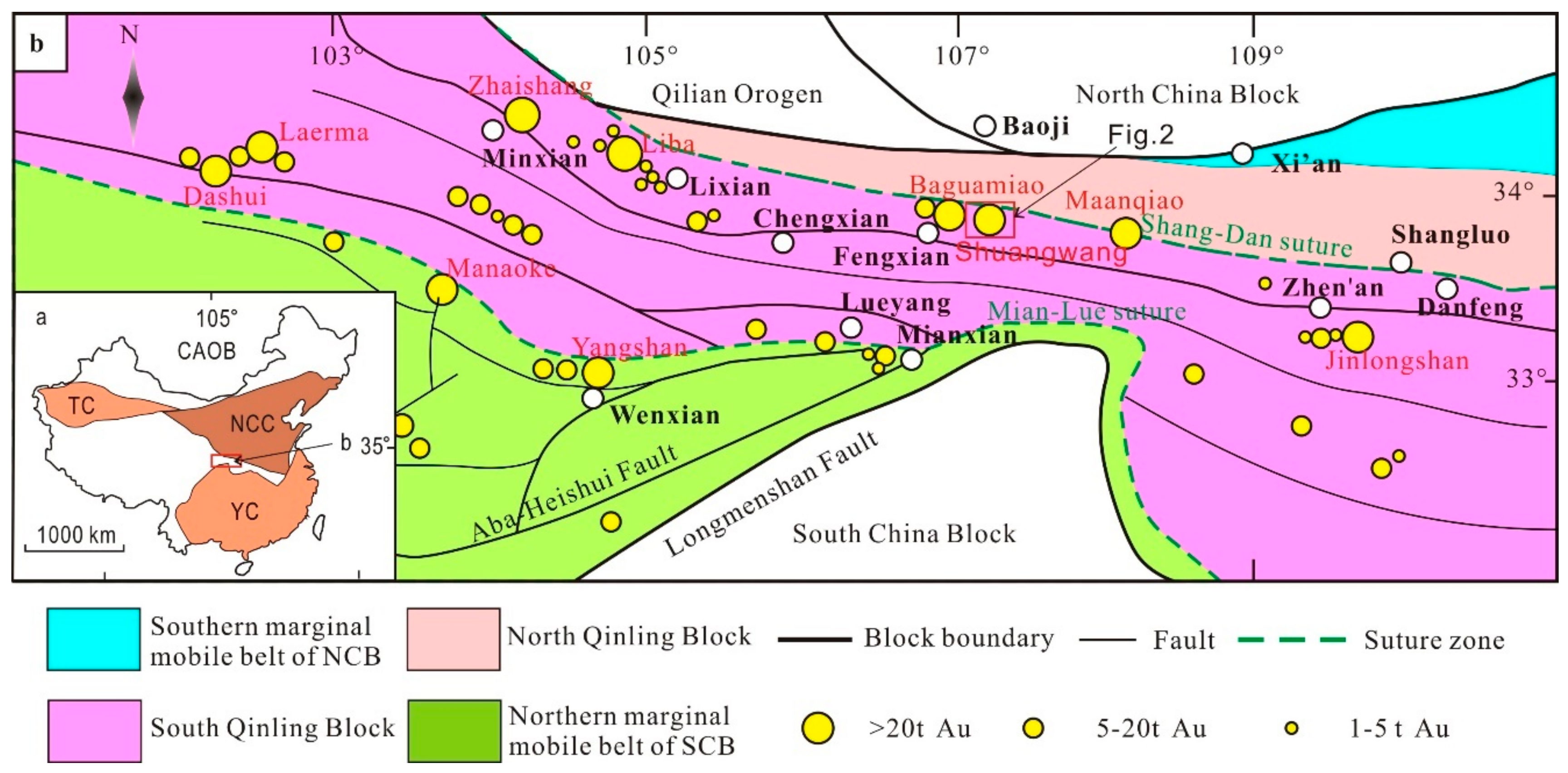
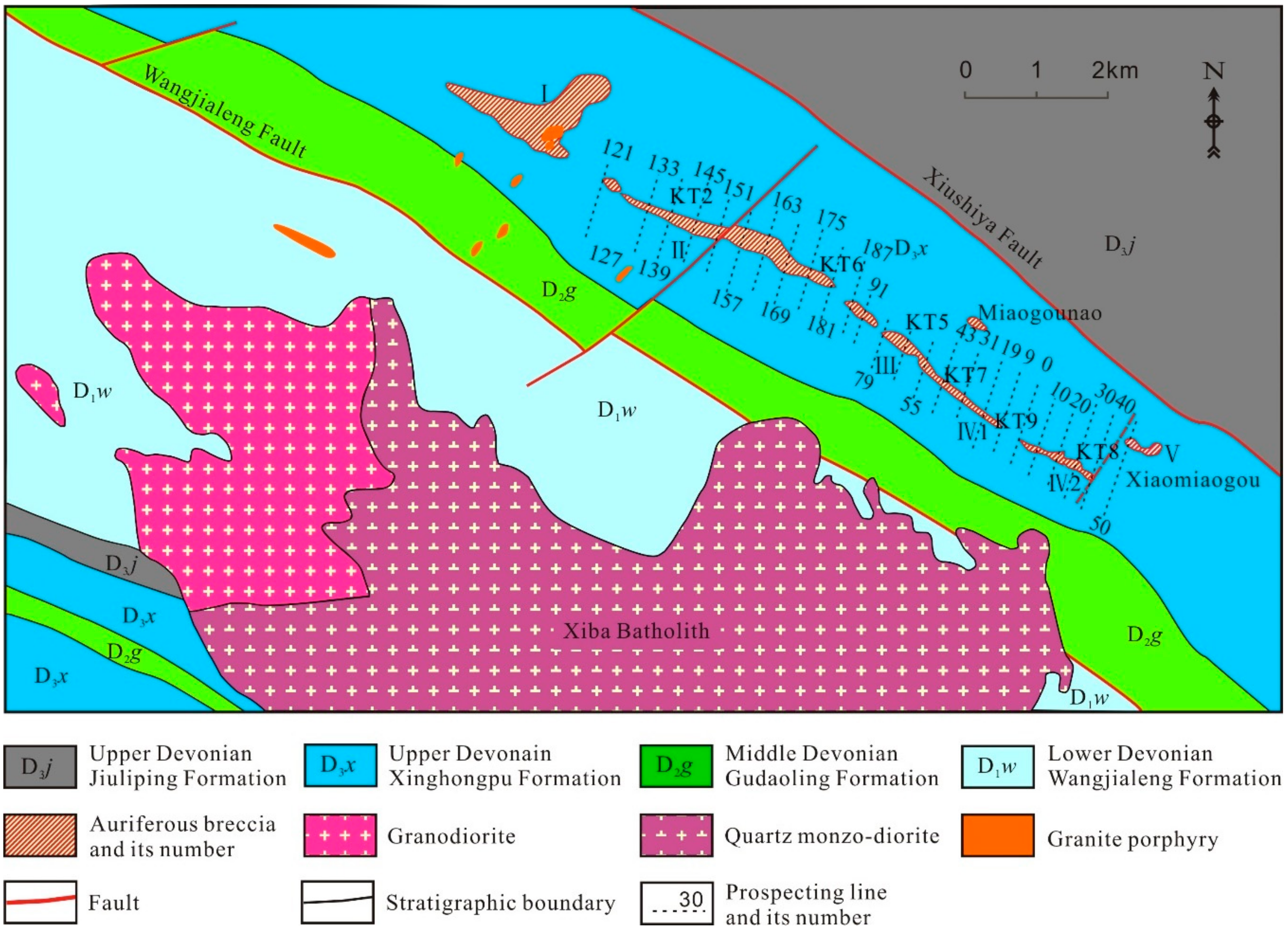
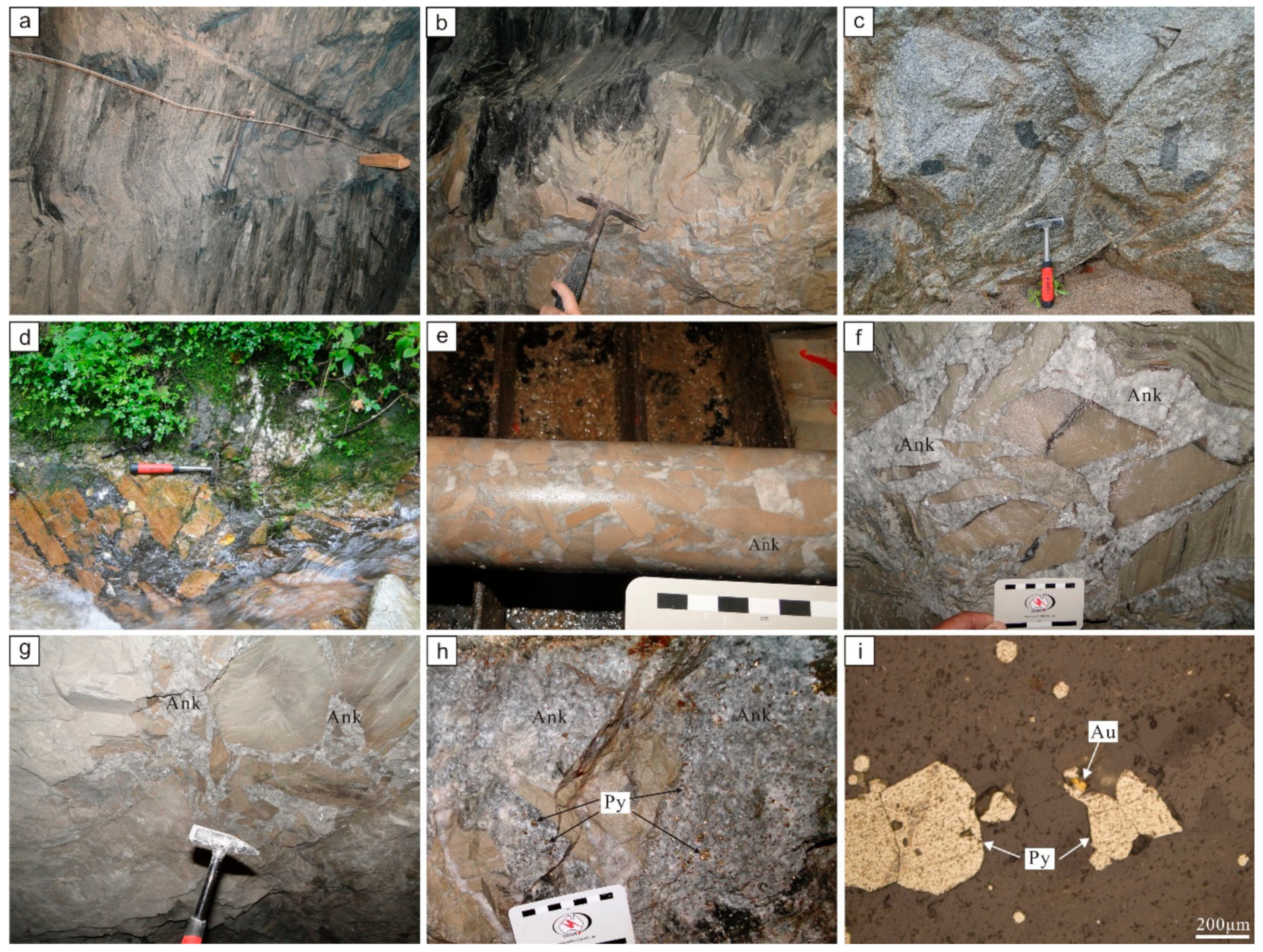
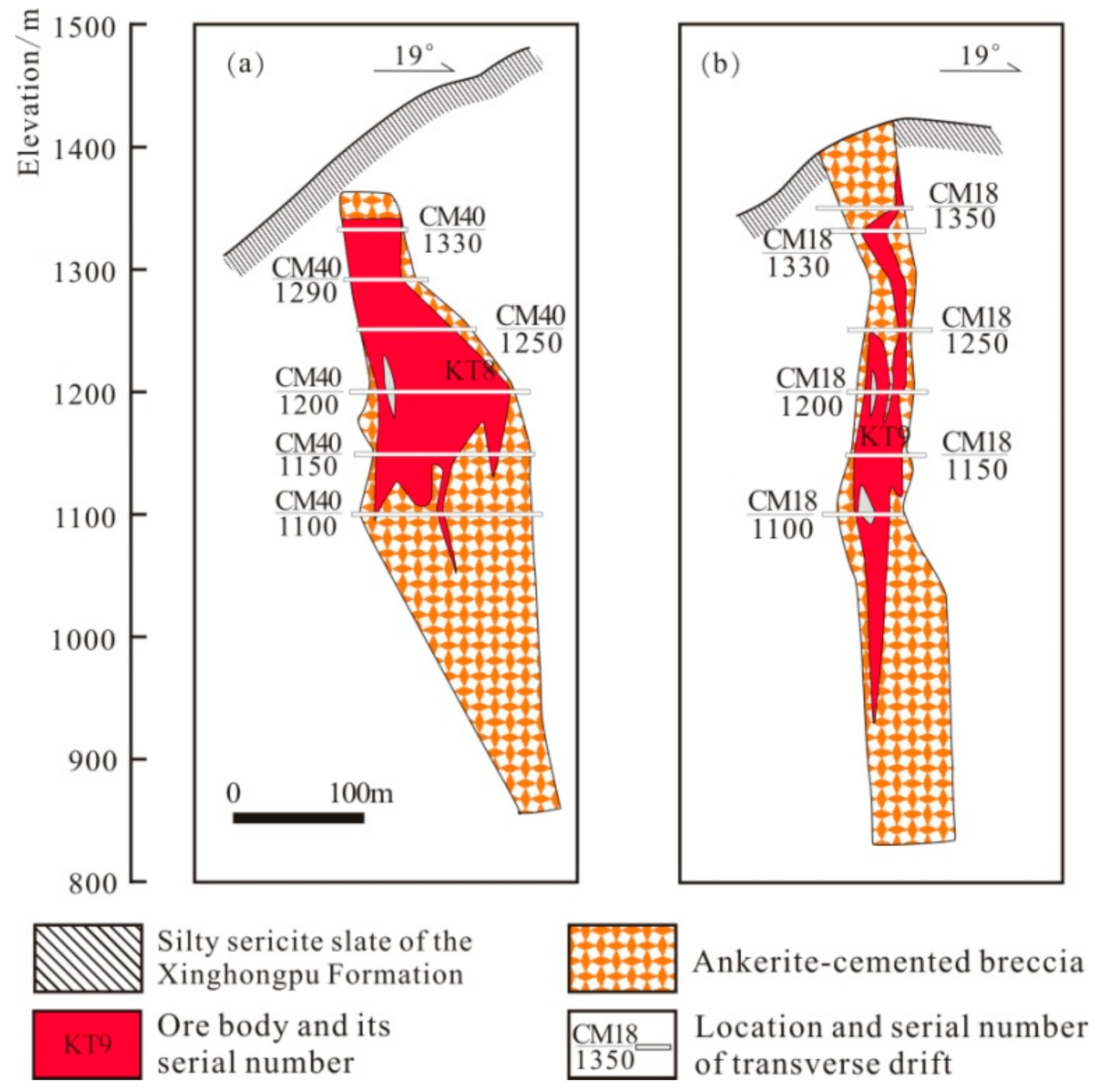


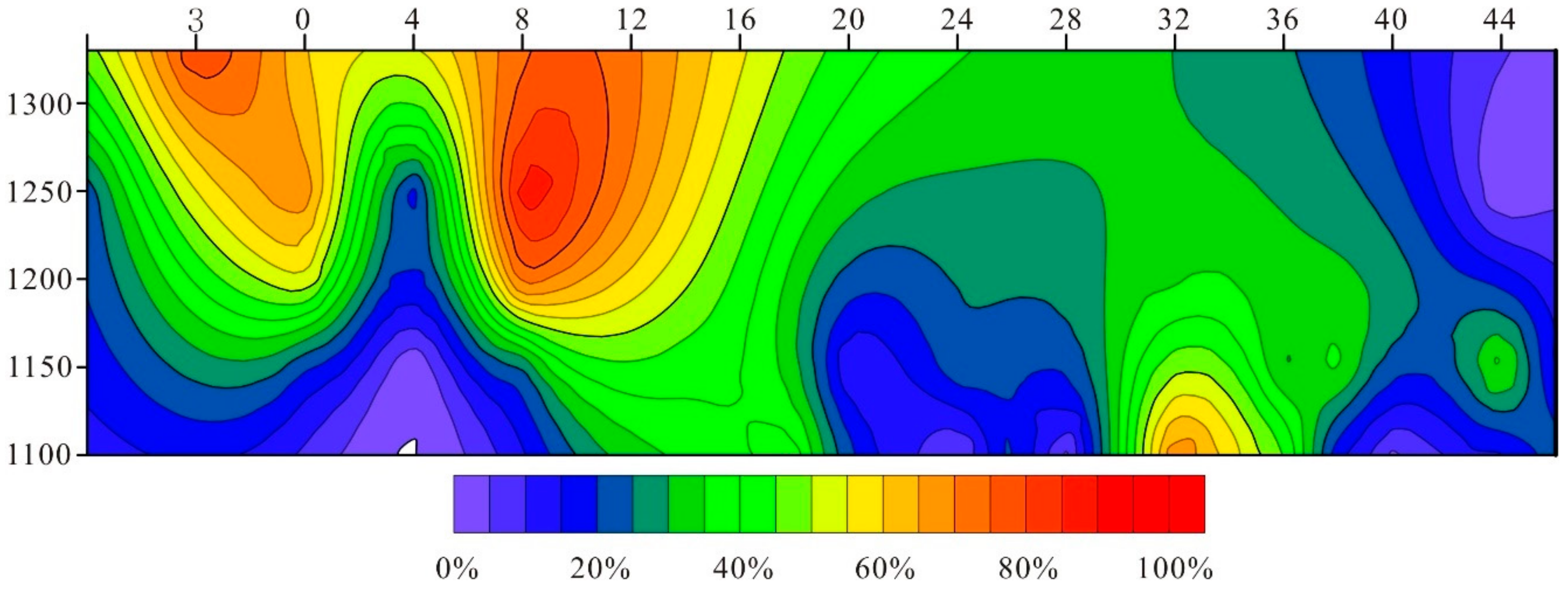
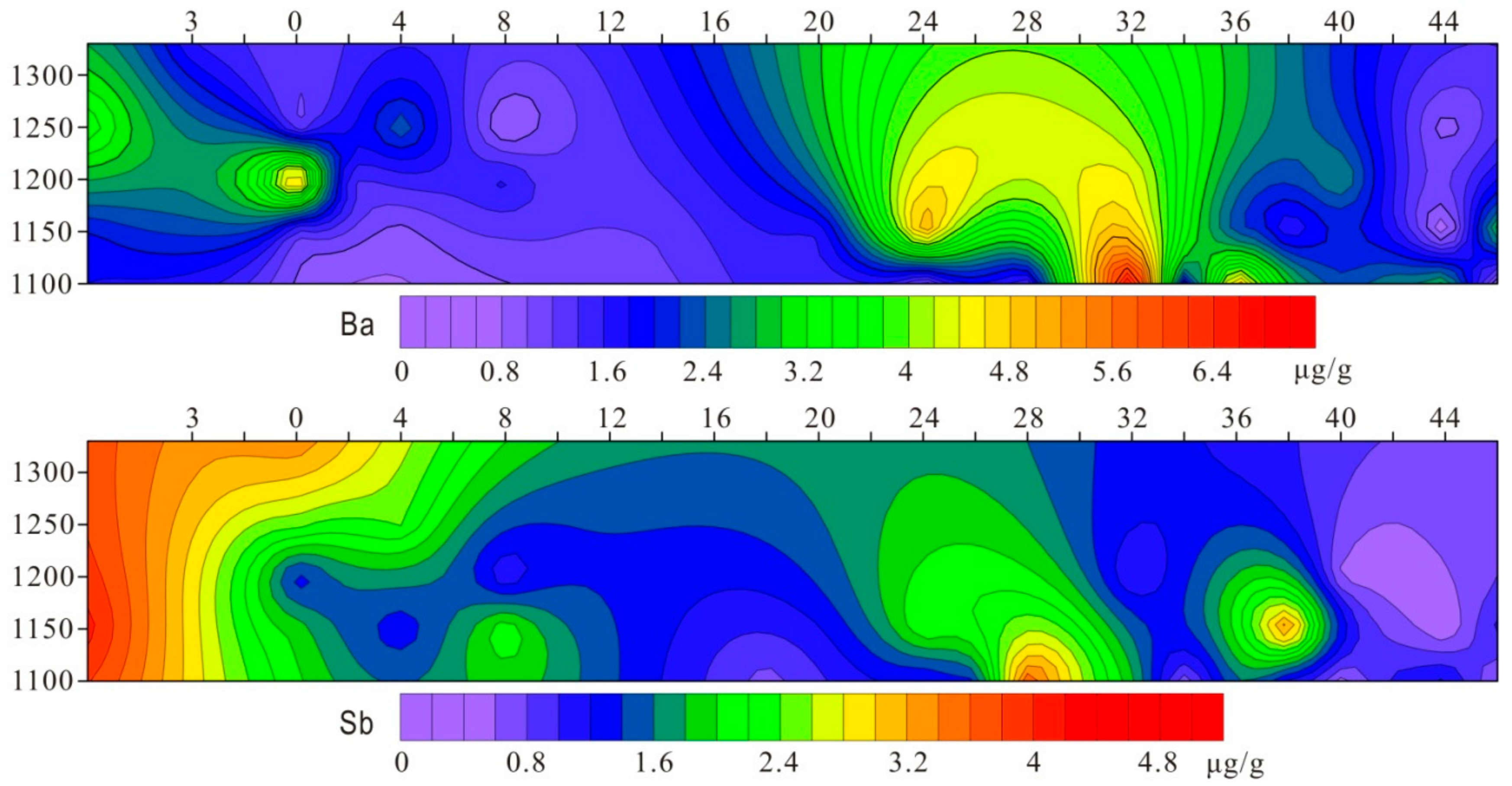
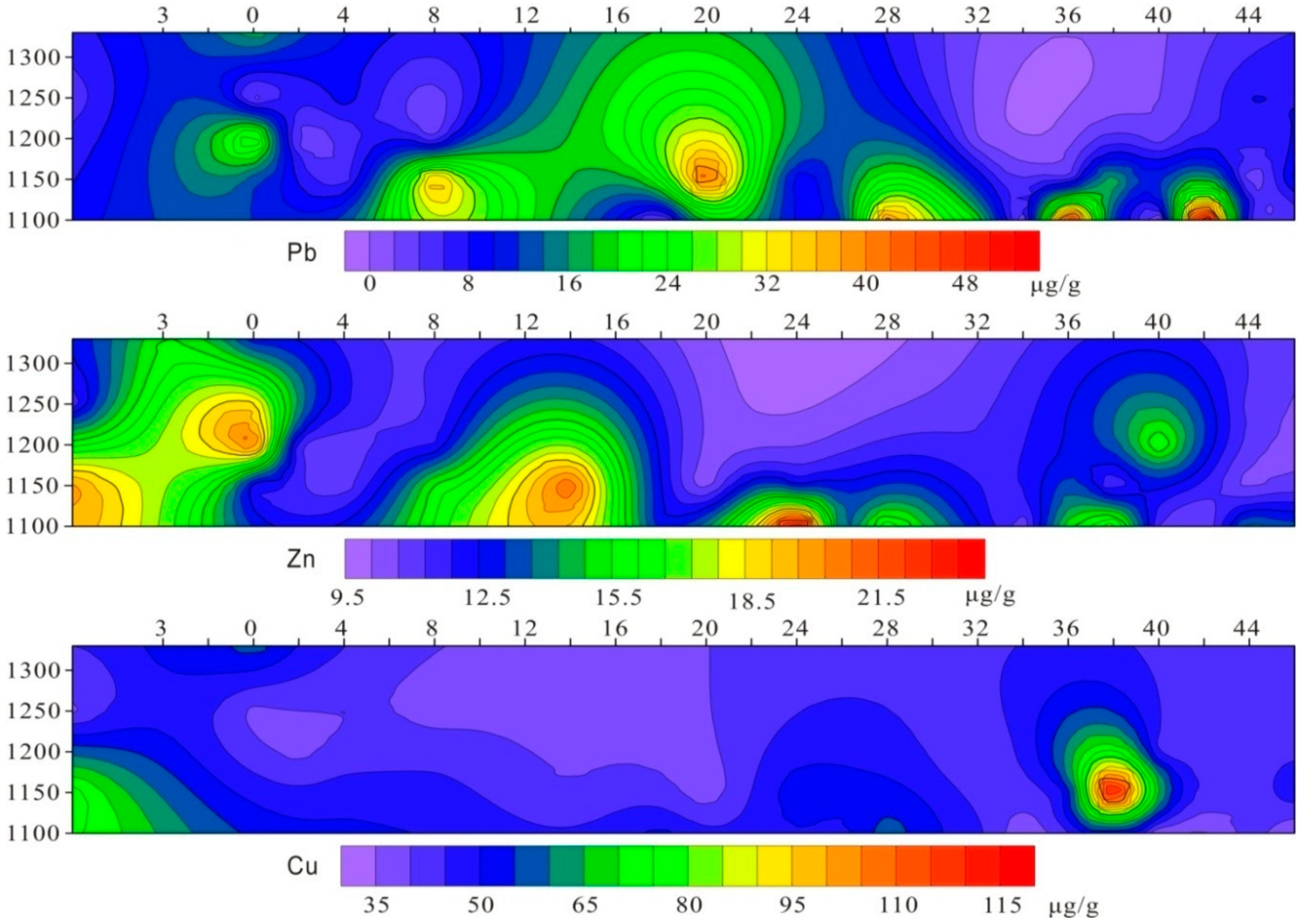
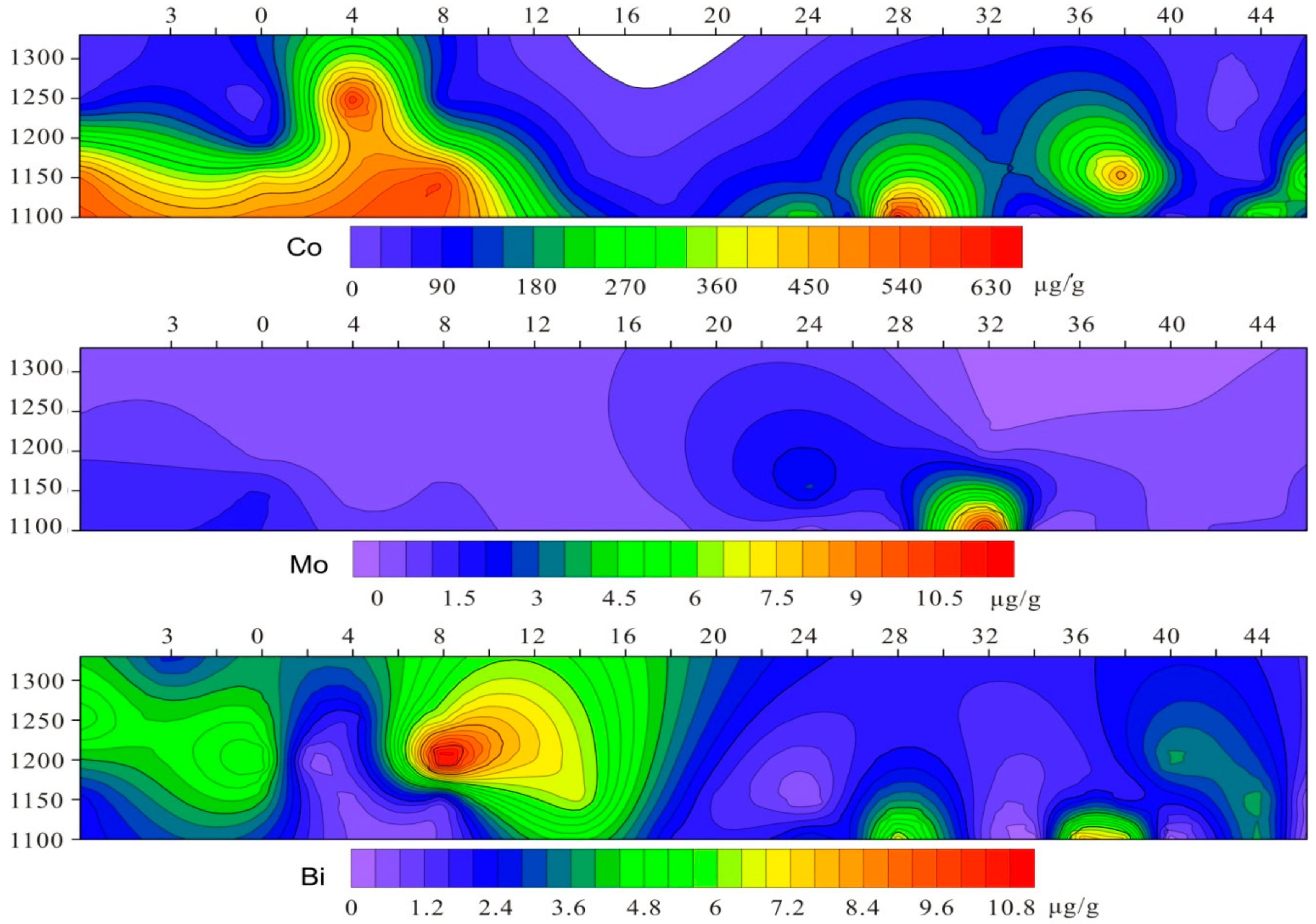
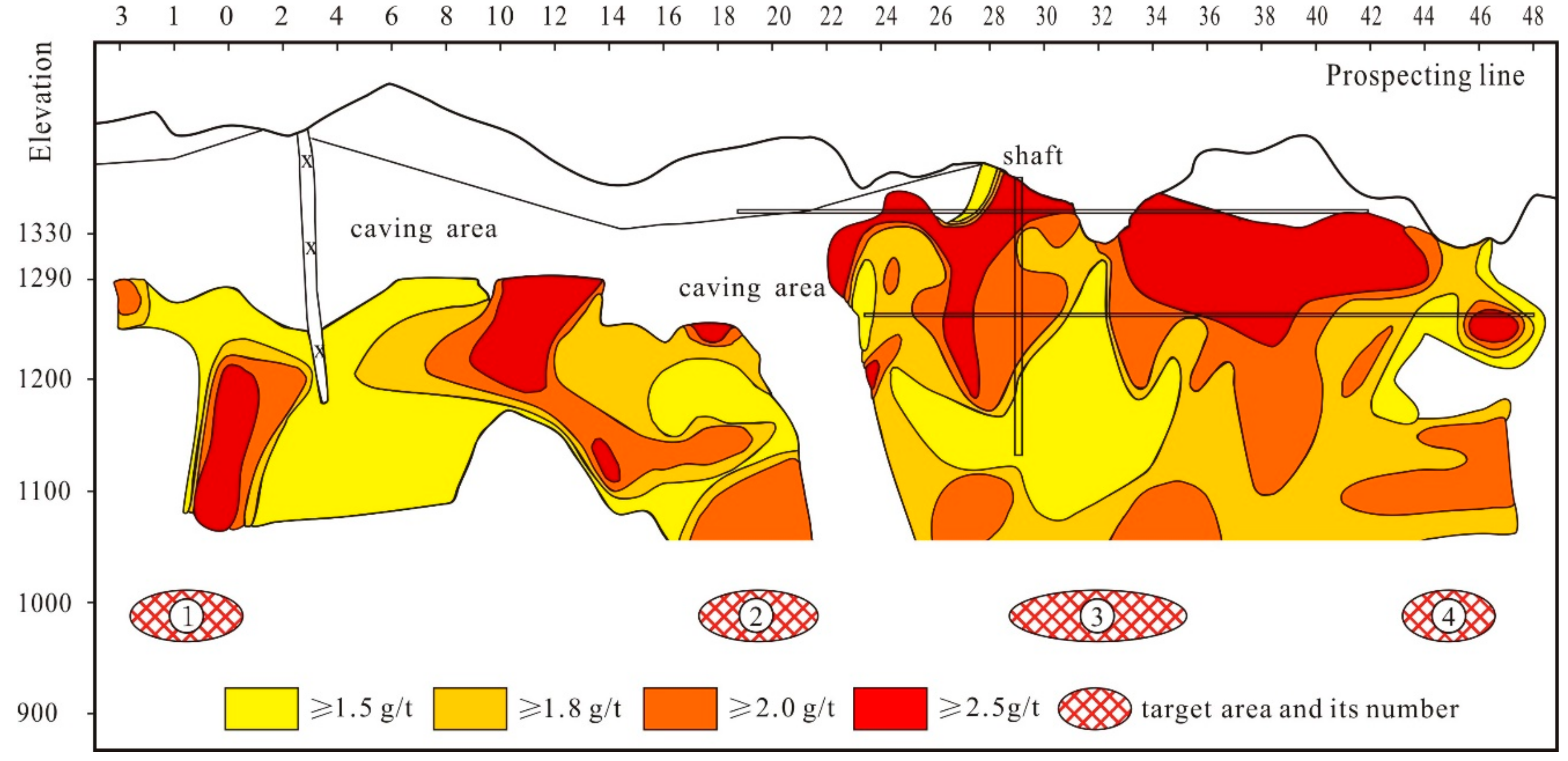
© 2019 by the authors. Licensee MDPI, Basel, Switzerland. This article is an open access article distributed under the terms and conditions of the Creative Commons Attribution (CC BY) license (http://creativecommons.org/licenses/by/4.0/).
Share and Cite
Wang, J.; Liu, Z.; Wang, K.; Zeng, X.; Liu, J.; Zhang, F. Typomorphic Characteristics of Pyrites from the Shuangwang Gold Deposit, Shaanxi, China: Index to Deep Ore Exploration. Minerals 2019, 9, 383. https://doi.org/10.3390/min9060383
Wang J, Liu Z, Wang K, Zeng X, Liu J, Zhang F. Typomorphic Characteristics of Pyrites from the Shuangwang Gold Deposit, Shaanxi, China: Index to Deep Ore Exploration. Minerals. 2019; 9(6):383. https://doi.org/10.3390/min9060383
Chicago/Turabian StyleWang, Jianping, Zhenjiang Liu, Kexin Wang, Xiangtao Zeng, Jiajun Liu, and Fangfang Zhang. 2019. "Typomorphic Characteristics of Pyrites from the Shuangwang Gold Deposit, Shaanxi, China: Index to Deep Ore Exploration" Minerals 9, no. 6: 383. https://doi.org/10.3390/min9060383
APA StyleWang, J., Liu, Z., Wang, K., Zeng, X., Liu, J., & Zhang, F. (2019). Typomorphic Characteristics of Pyrites from the Shuangwang Gold Deposit, Shaanxi, China: Index to Deep Ore Exploration. Minerals, 9(6), 383. https://doi.org/10.3390/min9060383





